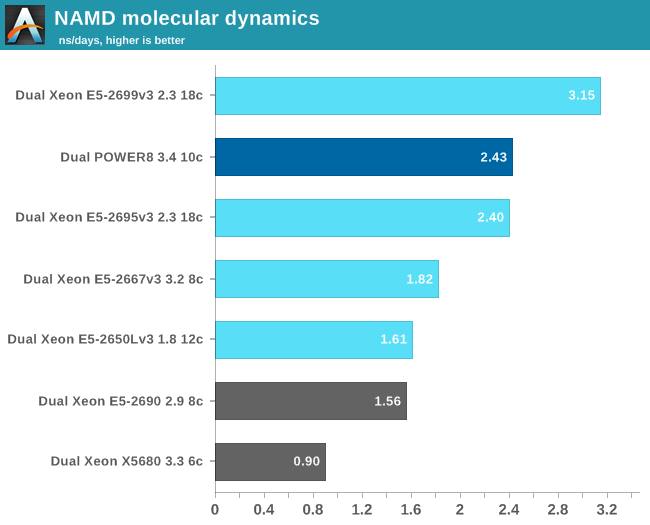The IBM POWER8 Review: Challenging the Intel Xeon
by Johan De Gelas on November 6, 2015 8:00 AM EST- Posted in
- IT Computing
- CPUs
- Enterprise
- Enterprise CPUs
- IBM
- POWER
- POWER8
Floating Point: NAMD
After quite a bit of trouble, we managed to port a real floating point application to our POWER8 system: NAMD.
Developed by the Theoretical and Computational Biophysics Group at the University of Illinois Urbana-Champaign, NAMD is a set of parallel molecular dynamics codes for extreme parallellization on thousands of cores. NAMD is also part of SPEC CPU2006 FP.
We used the "NAMD_2.10_Linux-x86_64-multicore" binary for our Xeons. Since there was no LE Linux version for POWER8, we built our own. We got it working with the g++ compiler and used these settings:
-O3 -mcpu=power8 -ftree-vectorize -mpopcntd
These setting should push GCC to generate as much VSX (Vector Scalar eXtenstion) code as possible. We used the most popular benchmark load, apoa1 (Apolipoprotein A1). The results are expressed in simulated nanoseconds per wall-clock day.

To put this in perspective: an early Xeon Phi (7120 1.2 GHz) scores about 4.4, A top NVIDIA GPU with CUDA based NAMD can score up to 20 and more. So it is clear that this kind of software will be run mostly on GPU accelerated servers.
But it is nonetheless a real world HPC benchmark. The IBM POWER8 is once again on par with the Xeon E5-2695v3. The NAMD binary does not seem to leverage AVX2, as the Xeon E5-2667 (16 cores) does not outperform the Xeon E5-2690 (AVX) with a large margin.










146 Comments
View All Comments
JohanAnandtech - Saturday, November 7, 2015 - link
Ok, Europe adopt the dot, but maybe the US can adopt the metric system like the rest of the world? :-)bitaljus - Saturday, November 7, 2015 - link
or better yet recode this site to see from what country u are visiting and use the appropriate denote thousands symbol, appropriate metric system and even time for the viewer. how meany time i was irradiated when i need to google something like this just to make it in local. and this is easy to do in the site natively. (P.S. Sorry for bad English, not native)nils_ - Wednesday, November 11, 2015 - link
The browser already sends a header with Accept-Language, which should be the preferred way to for the web site to determine locale. For example, I live in Germany so my browser will send en, en_UK, en_US, de and DE (this can be set somewhere in the settings). Now you can determine the language and other localisation based upon that, and there are tools where you can set the locale to then display dates, times etc.. based n that.Many sites instead use Geolocation based on the IP address, which can be really awkward when you travel to a country where you can't read the language.
ZeDestructor - Saturday, November 7, 2015 - link
Even within EU it's not consistent.. UK uses commas for thousands, dot for decimal (and that's why the US and most anglophone countries use the same setup), Germany, Netherlands and France on the other hand favour dots for thousands, commas for decimal, so you see it used there.. and in a great number of their former colonies where the language and culture has stuck.nils_ - Wednesday, November 11, 2015 - link
Dates / Time are even funnier, that's also extremely inconsistent and can be very misleading. Think for examle a date like 12/11/2015, in some countries it'll mean the 12th of November while in others it will mean the 11th of December, and sometimes even the 2015th of November in 11 AD ;)I remember reading on the GTA IV in-game "Internet" a travel guide to Europe that said the months here have 12 days but there are 30 months a year or something to that effect ;)
powchie - Friday, November 6, 2015 - link
let Johan do more reviews. been reading his stuff from late 90's and consider him the best then followed by Anand.Ryan Smith - Saturday, November 7, 2015 - link
Trust me when I say that if I could whip Johan any harder and make him work any faster I would be doing just that.;-)juhatus - Saturday, November 7, 2015 - link
When the Balrog showed up for work he had everyone fired.ruthan - Friday, November 6, 2015 - link
In summary should be something about software support, raw power is here, but software stack isvery limited.
PowerCPU is good for old legacy apps - SAP, Oracle etc.. but otherwise its dead end.
I would like to see comparision of IBM LPAR virtualization against Xeon Vmware solution, or Oracle / MySQL benchmark on power vs. Oracle benchmark on Xeon.
Server with Power even cant to run Crysis, or maybe some QEMU magic..
ruthan - Friday, November 6, 2015 - link
Pleas Ad edit button like other civilized sites, i was hurry when i wrote it.